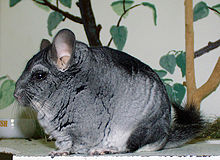The family Chinchillidae contains the chinchillas, viscachas, and their fossil relatives. They are restricted to southern and western South America. Often they can be found in the Andes. They are large rodents, weighing from 800 grams to 8 kilograms. They have strong hind legs and large ears. All species have thick, soft fur. Their fur is considered valuable in some species.[1]
| Chinchillidae Temporal range: late Oligocene – Recent
| |
|---|---|

| |
| Chinchilla brevicaudata | |
| Scientific classification | |
| Kingdom: | |
| Phylum: | |
| Class: | |
| Order: | |
| Suborder: | |
| Infraorder: | |
| Parvorder: | |
| Superfamily: | |
| Family: | Chinchillidae Bennett, 1833
|
Classification
changeThere are three extant and three fossil genera currently recognized.
- †Eoviscaccia incertae sedis
- Subfamily Chinchillinae
- Chinchilla – chinchillas
- Lagidium – mountain viscachas
- Subfamily Lagostominae
- Lagostomus – plains viscachas
- †Pliolagostomus
- †Prolagostomus
References
change- ↑ Bishop, Ian (1984). Macdonald, D. (ed.). The Encyclopedia of Mammals. New York: Facts on File. pp. 702. ISBN 0-87196-871-1.
- McKenna, Malcolm C., and Bell, Susan K. 1997. Classification of Mammals Above the Species Level. Columbia University Press, New York, 631 pp. ISBN 0-231-11013-8
- Woods C. A. and C. W. Kilpatrick. 2005. Hystricognathi pp. 1538–1600 in D. E. Wilson and M. A. Reeder, eds. Mammal Species of the World, 3rd edition, p. 1553.